5 key facts about this project
The primary function of the project is to serve as a versatile setting that can adapt to various activities, thereby enhancing community engagement. The layout is characterized by open spaces that promote flexibility. By incorporating multipurpose rooms, the design allows for a range of uses from social gatherings to educational events. This adaptability contributes to the longevity of the structure and ensures that it remains relevant in the face of changing community needs.
A key aspect of the design is its materiality. The architects chose locally sourced materials, which not only reduces the carbon footprint associated with transportation but also connects the building to its geographical context. The prominent use of exposed timber, combined with stone cladding, creates a warm and inviting aesthetic while also ensuring durability. Glass elements are integrated to maximize natural light, offering transparency and a visual connection to the outdoors. This approach to design reflects sustainable architecture principles, enhancing the building's energy efficiency while creating a pleasant interior atmosphere.
The spatial organization of the project is particularly noteworthy. Careful consideration has been given to the flow of movement within the space. Walking paths are intuitively designed, guiding users through the project while allowing for spontaneous interactions. This deliberate layout encourages social engagement and fosters a sense of community among visitors, aligning with the project’s intended purpose. In addition, the strategic placement of windows and skylights enhances connectivity with the surrounding landscape, bringing the outside in and enriching the user experience.
Unique design approaches are evident in various architectural details throughout the project. The incorporation of green roofs not only contributes to biodiversity but also improves insulation and stormwater management. These elements are reflective of contemporary architectural practices that prioritize environmental stewardship. The use of modular building components further exemplifies the project's innovative approach, enabling quicker construction and greater efficiency without compromising aesthetic quality.
The project exemplifies a harmonious balance between functionality and form, showcasing the architects' ability to respond to the needs of the users while respecting the ecological context. The interplay of materials, light, and spaces creates a coherent narrative that is both practical and visually appealing. Each detail, from the selection of materials to the arrangement of spaces, has been thoughtfully considered, contributing to an overall design that is responsive to its environment and community.
For those interested in a more detailed exploration of this architectural endeavor, examining the architectural plans, sections, and various designs can provide deeper insights into the innovative ideas that shaped this project. Engaging with these elements will further illuminate the unique characteristics and functionality of the architectural design, revealing the careful thought and consideration that went into its creation.


 Bokeikhan Kamza,
Bokeikhan Kamza,  Bexultan Duisengaliyev
Bexultan Duisengaliyev 




















